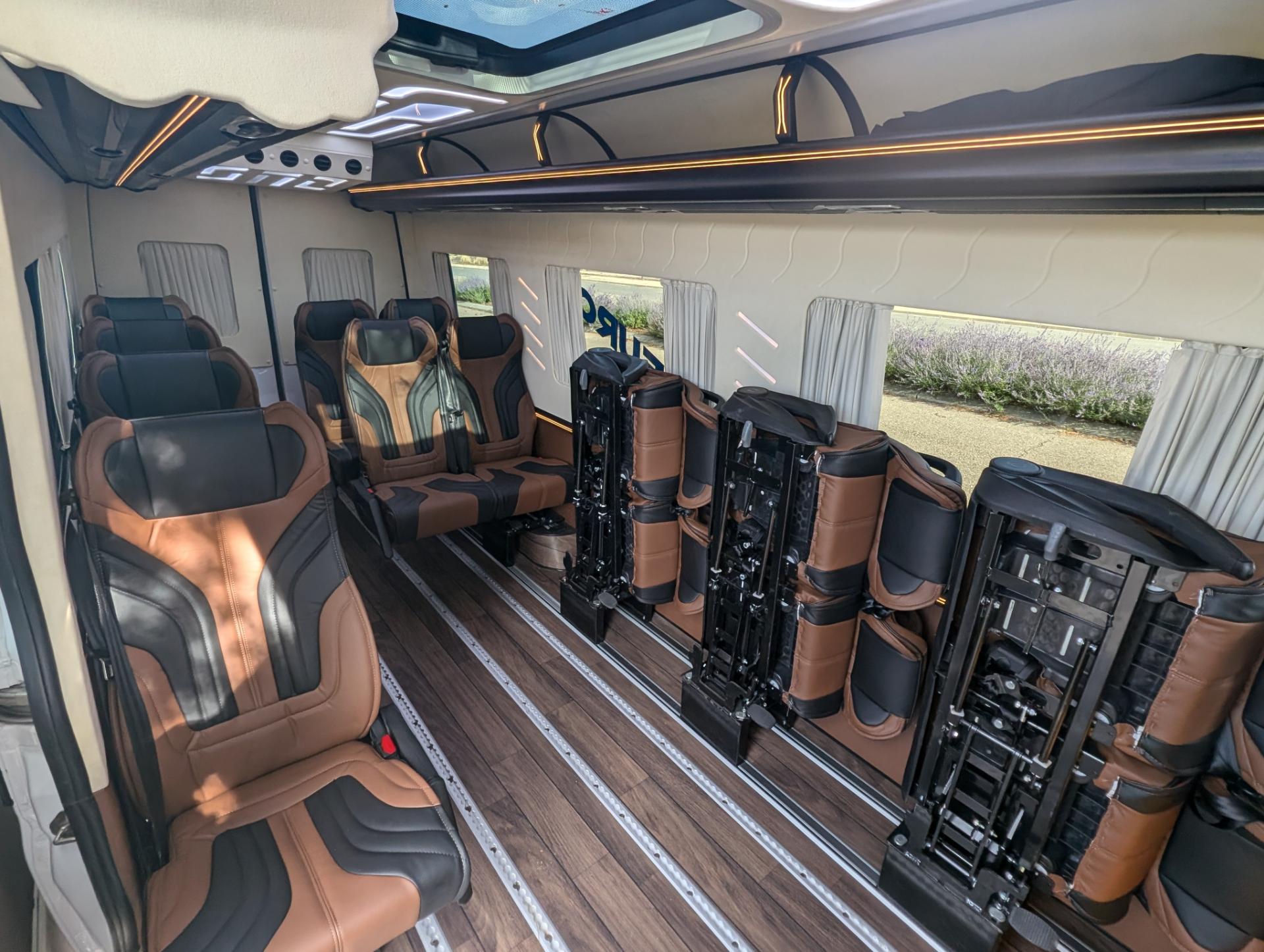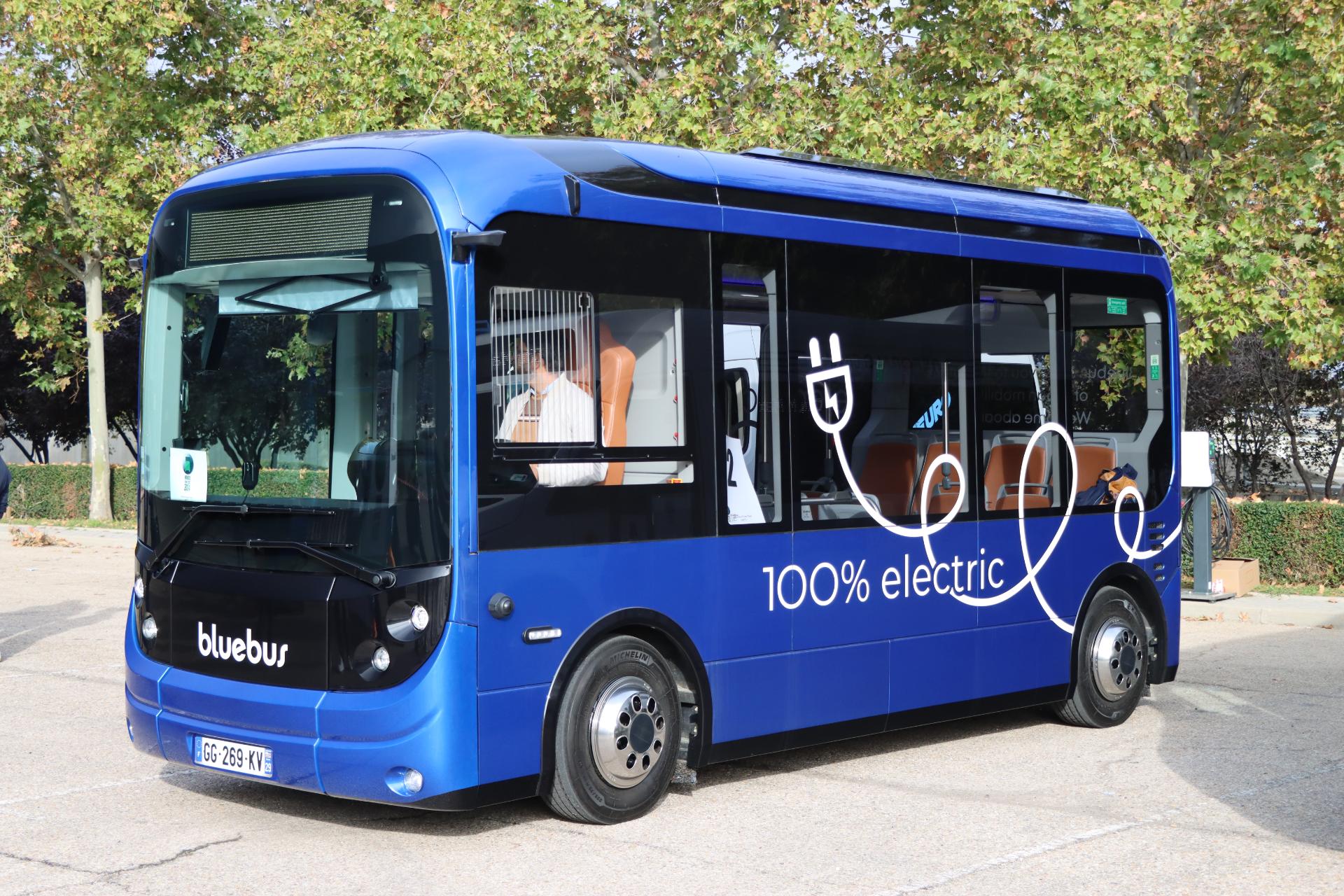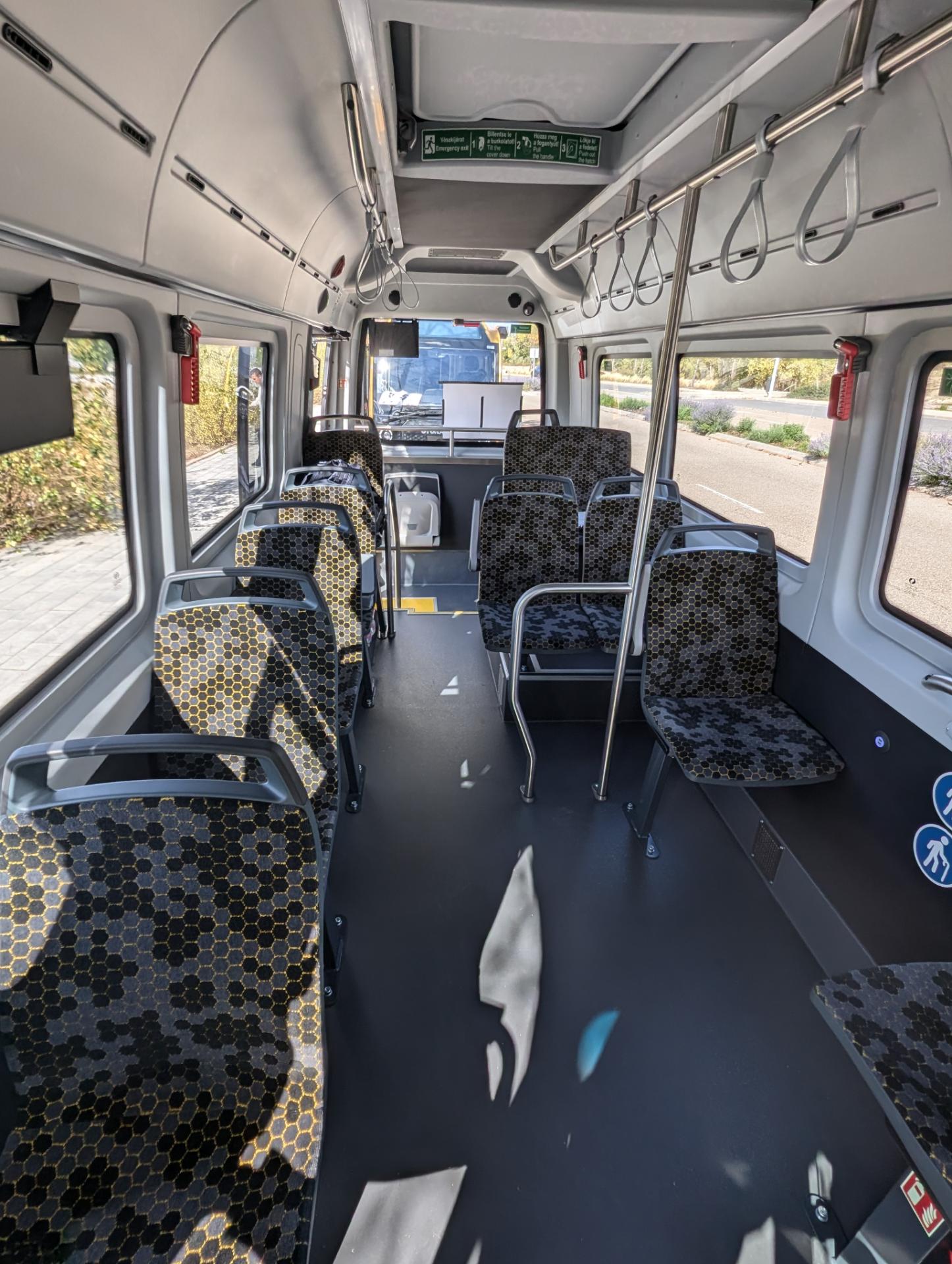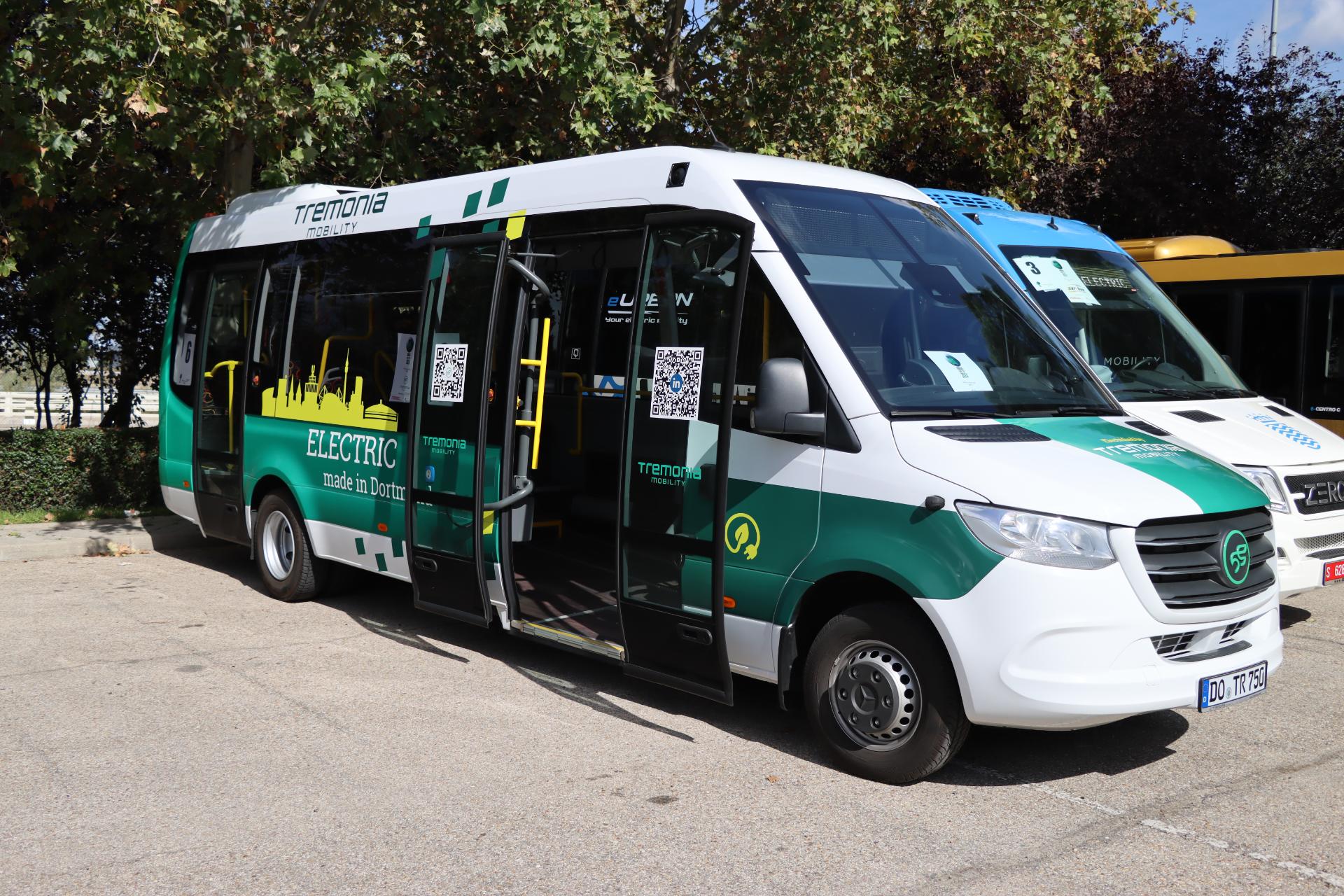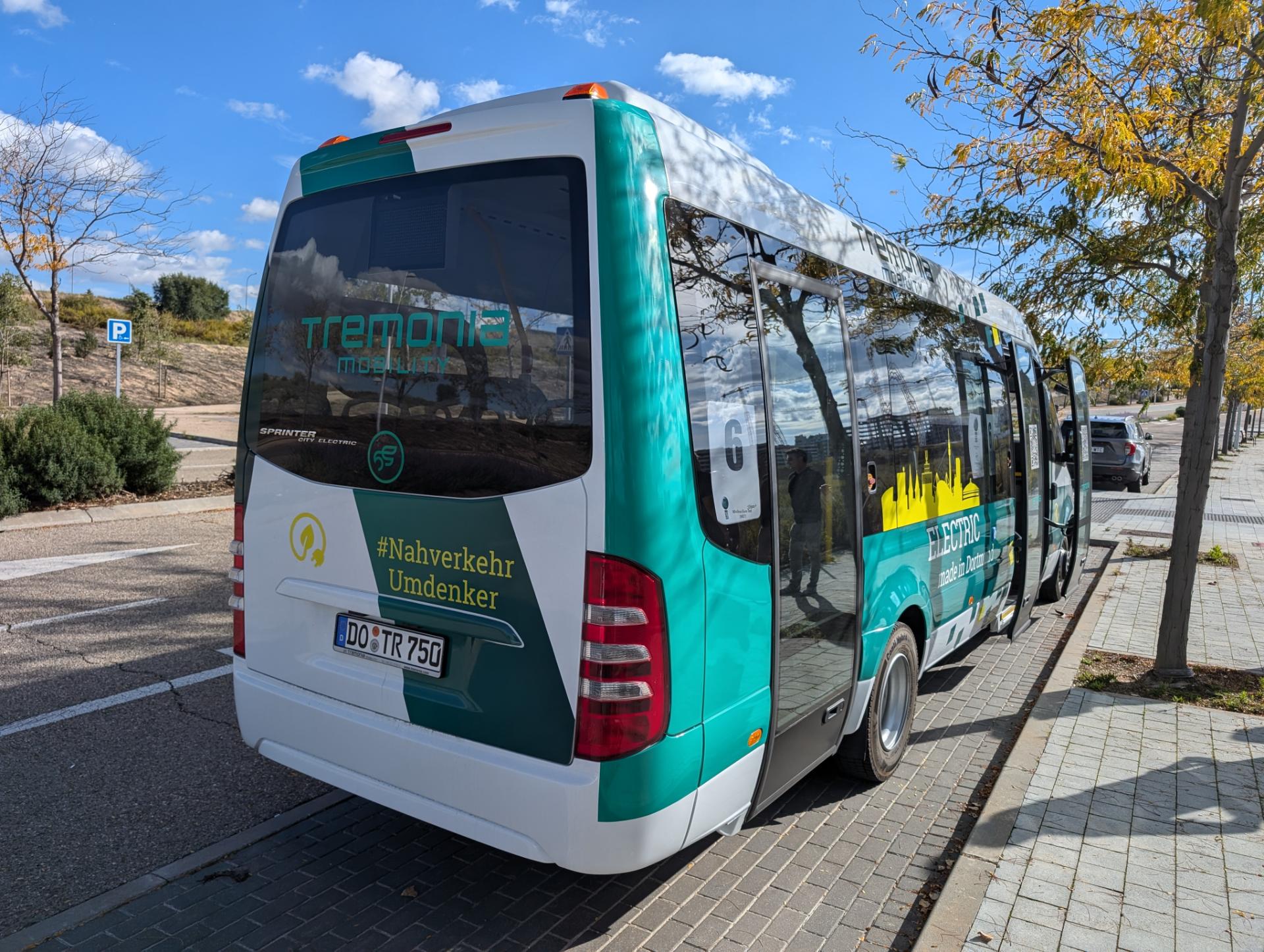Euro minibus shoot-out
The annual Minibus Euro Test saw six vehicles in contention, each on familiar bases vehicles though some bodybuilders unfamiliar to UK buyers. Our Founding Editor, Stuart Jones, is on the judging panel, and reports what he found
CLICK ON THE IMAGE ABOVE TO ACCESS THE FULL GALLERY
A record six entrants participated in the fourth International Minibus Eurotest in Madrid; an event held to enable the International Bus & Coach of the Year Jury to determine the winner of the International Minibus of the Year 2025 title. Staged over three full days prior to the FIAA’s International Bus and Coach trade fair at the Ifema Madrid exhibition complex it was organised in conjunction with Ifema, the FIAA and the Spanish magazine Autobuses et Autocares, mustering a very varied line-up of minibuses. These were the: Aveuro Mercedes-Benz Electric Sprinter conversion; the Car-Bus eUrban on Zeroid chassis; the Bluebus 6m; the Inter Traction Electrics Mercedes-Benz Reform-S City Max; the Otokar eCentro electric and the Tremonia Mobility City 75 Electric.
The International Bus & Coach of the Year Jury consists of senior journalists from 25 leading magazines, 24 of whom were present in Madrid. Only those who take part are entitled to vote. Unlike most international awards, which are purely paper exercises, the jury always holds a test to decide the winners of the bus, coach, and minibus awards. This involves experiencing all the vehicles on the road from a passenger and (where qualified) a driving perspective, technical presentations and walk rounds with representatives of the manufacturers, and a full debrief to discuss the performance of each vehicle before the ballot takes place. The test route is the same for all the buses and gives a clear insight into how they perform enabling jurors to consider each bus from passenger, driving, ownership, mechanical and ecological perspectives.
The candidates
Aveuro Mercedes-Benz eSprinter conversion
I had never heard of Aveuro before the last Minibus Euro Test, two years ago, but was impressed with the standard of the Mercedes-Benz Sprinter conversion they entered on that occasion. Fast forward to 2024 and they were back with another Sprinter conversion, this one based on the eSprinter and destined for a customer in Spain. The Romanian converters specialise in Sprinters, though they also produce on other bases, with large numbers of WVTA certified electric Ford Transits being manufactured this year and next for the home market and some Iveco Daily based electric city minibuses with Elinta electrical systems. The Transits are unusual for Aveiro and are the result of a government replacement hiatus in the home market that occurs every nine years; normally exports account for around 95% of production with Israel, France, and Spain key markets.
The coach entered was to a very unusual specification as it is intended for a variety of roles for a Madrid city operator undertaking airport transfers, school work and the carriage of people in wheelchairs. Fully tracked and with a Liftsa underslung cassette lift at the rear, it has convertible GRL double seats on the offside that fold away to the side, without the need for removal, when up to three wheelchairs are carried. I’m not sure how durable it will prove in service, but the saloon body sides are soft trimmed in a light beige colour. The roof is distinctive, with illuminated cut-out panels either side of a glazed roof hatch, and there are full racks on both sides. To the front of the compartment, behind the driver a large screen is mounted centrally beneath which is a full width unit that incorporates five separate illuminated compartments. Seats are leather trimmed in brown and black and do not recline. Engin supply the front electric rearward sliding door and the step that deploys when it opens, while the rear twin doors are standard Sprinter. Windows look deep from the outside but are standard units encased by framing.
As a Mercedes-Benz Van Partner, Aveuro try to change their Sprinter drivelines as little as possible from the original Daimler specification, to maintain the warranty and benefit from the dealer network in export markets. The electric Sprinter features driven single rear wheels and this is a limiting factor for convertors wanting to further develop the platform to give greater capacity. It has 113kW high voltage batteries, a 100kW electric motor and an adjustable recuperation level. Charging can be AC at 11kW or DC at up to 115kW using the CCS2 connection.
The vehicle price in Spain, as tested, is close to Euros200,000 although Avuero MD, Vlad Papuc, predicts that prices for electric minibuses will fall significantly over the next two years.
Impressions
The unusual mix of features is an attempt to create a vehicle that can be used 18 hours a day, and to a considerable degree it succeeds, with a favourable first impression for passengers. It also seemed relatively free of body noises. My criticisms are that this is not an easy minibus to keep clean, with a lot of light-coloured soft trim in areas that can easily get marked. The enclosed areas around the windows and the curtain rails are dust traps and the panelling takes up quite a lot of interior space which is lost to the person sitting next to the window, a position I found quite cramped for shoulder room. I’m not quite sure why the screen needed to be so large; it limits the passengers’ view, cuts the driver off from the passengers and one juror complained of hitting his head on the rear of it.
A number of drivers said that this was the best bus to drive, with good recouperation and one of the quietest, though there was some beeping as some of the systems had yet to be calibrated.
Bluebus 6m
Founded in 2007, Bluebus is a French company, based at Quimper in Brittany, that is part of the vast Bolloré Group. It has been developing electrical systems and vehicles for more than a decade and also builds full 12m city buses, several hundred of which are running in Paris. It employs 103 people and has already built over 100 of the 6m model entered following over 250 of its predecessor and around 600 buses in total. The skeleton in the cupboard is that a fault on the insulation of the in-house built Foresee batteries caused two Paris buses to catch fire and burn out, after which they were all withdrawn. The problem was identified as a badly placed isolator that could short inside the units. All the remaining buses were rebuilt and successfully returned to service prior to the Olympic Games earlier this year. Vehicles are built for export, with Indcar appointed to handle sales in Italy and Spain.
Part of the Bluebus philosophy is to use common parts for the 6m and 12m products, as far as it is practical to do so, and hence many units including the drivers cab and binnacle and the windows are shared. Similarly, the Hubner ramp and Ventura doors are parts developed for 12m buses. Drivers reported that this approach resulted in a cab that is more spacious than many minibuses and feels very like a big bus to handle, though obviously lighter. On the road it often looks somewhat alarming as there is a distinct lean when cornering, a phenomenon that is discernible inside the bus though I did not find it uncomfortable or disconcerting.
At 5.94m long, the shortest of the candidates, it nevertheless manages to accommodate up to 35 passengers, which is more than all the other buses entered. The big windows do help give it a feeling of spaciousness but I still think it would be uncomfortable with 35 people on board. That it can offer such numbers is down to the axle capacity, each of the two Brist independent wheel axles being certified for 4.5tonnes with a GVW of 8.5tonnes, a total a full 1.5 tonnes greater than the Tremonia City 75 electric’s 7.00tonne capacity. Tyres are 235/75R17.5. One 1232mm electric sliding door is situated midway along the bus within the 3.9m wheelbase and the nearside leans towards the kerb when necessary, enabling the ramp to be deployed. There are only 12 fixed seats, all but the back row of four directly accessible from the low floor area. Those in the front low section are cantilevered for ease of cleaning and there is a fixed wheelchair bay to the rear of the driver.
The ironic stainless-steel frame is totally welded and is produced by Bogdan in Western Ukraine. Purchasers can either specify solid state Lithium Metal Polymer (LMP) batteries or Li-ION Nickel Manganese Cobalt (NMC) from Rosse Power. Both offer 126kWh and are said to perform in the same way, though the solid-state units are slightly heavier and operate at a higher nominal voltage (400v against 350v) as well as having a considerably broader operating temperature band of -30 to +60 degrees centigrade over -10 to +40 degrees. Our bus had NMC units. They can be charged in two ways using either the 22kW on board charger or using the T2 plug at the rear, a process that takes around six hours and provides sufficient power to run for the full day. A range of 280km is claimed though lightly loaded and perhaps making fewer stops the bus covered 161km on the first day of testing using 60kW, which would have given it a range of 320km. The central electric motor has a maximum power output of 140kW maximum torque of 400Nm.
For the future, Bluebus already has an autonomous version running on a test track.
Impressions
History suggests that we Brits are not too keen on standee buses but I could see a lot of good in this for some short distance applications. The finish and materials were good, the suspension smoothed the ride well, and it looked distinctive enough to attract passengers.
Some jurors had an issue with the amount of lean in corners, though personally I did not, but most thought it well laid out and ‘the most like a big bus.’ Speaking to Irish judge, Sean Murtagh after driving it, he was enthusiastic. ‘The mirrors are well placed, it’s responsive, they’re good brakes, there are four positions for retardation, and it has good suspension,’ he said, adding, ‘there is a bit of roll on corners like an old (Leyland) Leopard.’
Car-Bus eUrban on Zeroid eC36
Car-Bus.net is a small but enterprising Spanish coachbuilder that has been trading under its own brand since 2006 having previously worked with other manufacturers, including Noge. The winner of the International Minibus of the Year title for 2023 with its coachbuilt Shoula based on a Sprinter uprated by the company, Car-Bus.net this time entered a bus that is similar in concept but also completely different. Mounted on the eC36 chassis from Zeroid, a Barcelona based company that imports chassis from China and modifies them for the legislational and operational requirements of the European market, the e-Urban body is a conventional European low floor minibus with a flat low floor section at the rear, large side windows, manual rear ramp, twin-leaf outward opening doors to the rear, single leaf rearward opening door to the front and roof mounted air conditioning pod. Though well finished, it was to a customer’s fairly basic internal specification with the two-tone plastic Fainsa seats that are popular in Spain.
The chassis specification on a standard C36 has transverse leaf springs at the front and leaf springs at the rear but this eC36s had the Muller rear air suspension system. The CATL LFP batteries are 140Kwh high energy units and are limited to 80kW charging via the CCS2 connection. Charging from 20% to 80% takes 2.5 hours. They carry an eight-year guarantee are installed within the wheelbase. Other electrical components such the inverter have a four-year guarantee. Dana supply the TM4 electric motor which is rated at 70kW with peak power of 150kW and torque of 1,200Nm. and mounted on the rear axle between the axle and the battery pack. Tyres are 205/75R17.5.
The body construction method is to pre-build the structure on a jig and then mount it on the chassis. The entire structure is epoxy protected and all the fibreglass panelling and single glazing is then attached. Five rows of seating are provided in a 1+2 layout in the main saloon, giving a seated total of 15, with the doubles on the offside and all seats mounted on podests. There are a further three tip up seats on the rear wall of the low floor section. The door is a Masats unit while the heating and air conditioning are from Webasto.
Impressions
While there was widespread praise for the body, jurors were less impressed with what it was mounted on. One comment came up repeatedly; everyone that drove it said the brakes were too slow to act. The first stage of the braking process is recuperation but even quite aggressive braking did not give the expected level of retardation, and pumping the brakes did not seem to help. Questioned about this, a Zeroid spokesman said that while it met all the legal requirements, the company would be revisiting the issue in the light of these comments. Jurors also disliked having to apply the cable handbrake before you could open the doors at a stop, a feature that would make it very difficult to utilise on city bus work. Further criticism was of the heaviness of the steering and the, sometimes confusing, layout of the cab controls. Rather more impressive was the stability of the vehicle, a point mentioned several times in our debrief session.
The overall impression gained was that this is a great body on a chassis that has a lot of shortcomings. Most converters and operators would have been very happy if Mercedes-Benz had come up with a heavier duty version of the Sprinter for bodybuilders to body, but having taken a big step away with the discontinuation of the Vario, it appears the advent of the eSprinter has seen it take another step back from the sector. As a result, converters are having to look elsewhere. The current offering may not fully fit the bill yet, but if the demand continues to be there, they, or others, will keep developing better options until it does. Zeroid is already working on a hydrogen fuelled solution which it expects to be available in 2026.
Inter Traction Electrics Reform-S CityMax Mercedes-Benz Sprinter 517D
It is perhaps odd that the only minibus with the word electric in the company name was also the only one that was diesel rather than electrically powered. It had been the intention to run it on HVO but unfortunately issues at the Madrid fuelling station where they had planned to refuel meant that they were unable to do so and it ran on diesel throughout the test. Hailing from Debrecen in Hungary, Inter Traction Electrics is part of the ITK Group, specialising in recycling and electric drivelines and is 95% owned by the petro group MOL. The group has a sister company operating over 700 buses in Hungary and as well as minibuses builds full sized buses on chassis built at Daimler’s Samano plant in Spain. It is the first converter in Hungary to successfully achieve Mercedes-Benz Van Partner status and is the general distributor for Daimler Truck in Hungary. It converts around 50 Sprinters annually in addition to large buses. As well as the City Max M3/1 class version of the Reform-S shown, there are also School, Intercity and Commute versions.
On the face of it not particularly exciting in that other manufacturers offer similar propositions based on uprated Sprinter 517D panel vans, but nevertheless this was a very competent conversion in the classic European dual-entrance mould with a manual-lift equipped low floor section at the rear provided for wheelchairs and buggies and the main seating area accessed by means of two steps through the ISAF electric front door. The interior was attractive and bright with a large rear window, though the side windows appeared to be of standard dimensions. I have never liked the flat low floor section configuration on minibuses because it is so easy for passengers to accidentally miss the steps and fall on a crowded bus, although the Reform-S does do more than most to safeguard against such an occurrence with excellent handrail provision on both sides of the aisle. Although the passenger capacity is 29, there are only 10 Kiel seats, plus a tip up in the rear section, so the accent is on standees with single seats on both sides in the main saloon to create the necessary space. Rails with straphangers are provided. Seats are Polish Kiel units trimmed in honeycomb style moquette, and the electric rear doors are by BCE.
As well as the standard diesel driveline with OM654 125kW engine and nine-speed ZF 9G-Tronic automatic transmission, the standard suspension and climate control system are retained. The front axle is uprated and a Telma retarder installed. Also provided are a Fogmaker fire protection system for the on-board heater and a BlazeCut T system for the engine bay. Two cameras are provided in the saloon and a very informative display screen that is produced in-house by ITK. A clever development of this on some buses is that student’s passes also check them in at school so that parents know where they are.
Impressions
Aside from the fact, mentioned by several jurors, that operators in their nations would not be allowed to purchase new diesel minibuses, most of the comments on the bus were very positive. HVO as a sustainable alternative was a viable alternative to diesel and was already proving popular in Italy with no noise and no smell being among the attributes. There was particular praise for the ‘perfect’ set-up of the LVRS350 retarder as well as the performance of the gearbox.
Inside it was equipped with LED lights, and the driver was visible to passengers, further aided by a split screen camera that enabled constant monitoring of the interior. The only real criticisms were regarding the doors, that at the rear being very slow to open, while the front unit was low and it was necessary to duck to avoid bumping your head, a point MD Gabor Kozicska took on board and intends to address. At Euros120,000 it was far more affordable than other candidates.
Otokar eCentro electric
A major Turkish manufacturer with a full line of bus and coach products, Otokar has been supplying minibuses and microbuses like the 6.6m long Centro for many years as there has traditionally been a huge market for them in Turkey. It does build in left hand drive, as large orders for Kent and Vectio C in Malta attest, but the eCentro is only offered in left hand drive. It can also be a diesel bus with 4-cylinder Cummins engine, and in contrast, can be supplied as an autonomous electric with a project soon to commence in Spain.
We know that the eCentro works because the example we tested had already put in 46,000km in 18 months, taking golfers and their trolleys to and from six golf courses in Mallorca. This work accounted for the rather non-standard interior layout that saw additional decency rails installed at regular distances in the offside low floor area, enabling golfers to sit in a tip-up seat and keep charge of their trolleys when travelling.
Ten Sege fixed seats in a 2+1 configuration are installed at the rear with steps and podiums involved in reaching all but the first three. A further six tip-ups are available in the forward low floor area where the wheelchair bay would normally be located immediately behind the driver. Maximum passenger capacity is 32, either 10 seats and 22 standees or 16 seats and 16 standees, with a wheelchair reducing this to a maximum of 28. Tarabus covers the floor and there is a Hidral Gobel Vicoli powered ramp at the single doorway, where Turkish built doors are fitted.
The driveline is truly international. The rear axle is a Qingdao Qingle 5 tonne unit, the heating and ventilation system is by Cling and the steering pump is also Chinese. Otokar manufactures the NMC traction batteries in-house mounting both 55kWh units beneath the floor to give a total capacity of 110kWh for the 523volt system. Dana Motor supply the TMS4 SOMO LD HV1200-3P which can be charged either using AC or DC. Charging at 120kW the bus reaches capacity in around 1.5hours. Maximum power is 200kW with a 110kW continuous rating. Maximum torque is 1,200Nm. Although a 275km range is advertised, the ‘real condition’ is around 200km we were told. Wheels are 16 inches.
Impressions
Visually appealing inside and out, the eCentro suffered a little from poor internal panel fit in places and some of the plastics could have been less flimsy. With air suspension on the front axle only, the ride quality was impaired and bumps could be jarring. My perception was that it was the noisiest of the participants with this generated from a number of sources. In fairness, it may be that the fact it was not new contributed; all the others were either demonstration buses, show exhibits or fresh from the factory.
Drivers complained of poor visibility in direct sun, indicators that did not turn off automatically, difficulty adjusting the steering column, too much noise – especially when accelerating and recuperating, and slow two-step starting. Alone among the entrants the eCentro had a key ignition system. Positives included stability with the batteries low mounted, good recuperation, excellent retarder control and fast opening (though noisy) doors. The price tag of Euros 275,000 seemed high in comparison with other buses we saw, especially considering the vehicle size.
Tremonia Mobility City 75 Electric
Tremonia is the old Roman name for Dortmund and Tremonia Mobility is the new name for what was formerly Mercedes-Benz Minibus GmbH, the Dortmund based business which once produced the conversions sold directly through Mercedes-Benz and EvoBus outlets. Following the restructuring that saw the creation of Daimler Truck, it was decided that the operation was no longer core and in 2022 it was sold, though it does still produce conversions for Daimler for some right-hand drive markets, but not the UK or Ireland. For the new business it has been a steep learning curve and the workforce has grown from 240 to 270 as a result as aftersales, storage, IT, HR, and many other functions have had to be built up from scratch.
Most vehicles are still Sprinter based, though 20 wheelchair accessible VW Crafters have been built and can still be ordered. Annual production at Dortmund is currently around 1200 units, of which around 120 are City 75s (including diesel), 240 are City 45s and between 500-600 are to the more basic transport specifications. The business is continuing to expand into new markets having joined forces with EVM in the UK. It has no representation in Spain yet but was exhibiting at FIAA to gauge interest and seek potential partners. It was only in 2023 that the business decided to go electric, starting with the City45. The design of the electric Sprinter does not permit the batteries to be split and relocated elsewhere within the chassis, leading Tremonia to turn to Elinta, the Lithuanian electric equipment manufacturer, because it considered it the best on the market and the one most likely to be able to provide the necessary 15-year parts guarantee.
The longest of the six participants at 8.468m, the City 75 looks like the previous Sprinter City 75 offered by Mercedes-Benz (winner of the Minibus of the Year award in 2018) apart from the Eagle motif on the grille, but underneath this is a very different beast because the fledgling concern is no longer constrained by the necessity to source all of its components from the Daimler parts bin. It arrives at the factory from Mercedes-Benz as a diesel base vehicle, and very little of this remains once it has been prepared. Major parts such as the engine just are not needed and either go into the stores or are sold to customers at a discount, with some items now returned to the original supplier. The 5.0tonne air-suspended rear axle was specially designed for the application by Oberaigner. Once the chassis is prepared, it is united with a KTL dipped and powder coated steel body frame structure produced in Salzgitter. The rest of the build process all takes place in Dortmund.
Three sets of NMC batteries are located over the front axle, under the cab and behind the rear axle giving a combined capacity of 126kWh. They are guaranteed for eight years or 250,000km and an optional cooling system is available to protect them. The liquid cooled electric motor generates 160kW and 1,260Nm. Charging capacity is 13.2kW AC or 120kW if fast charged using a CCS system. Economy of around 50kW per 100km is likely, although all the manufacturers pointed out that driving style can make a huge difference to this.
Passenger capacity is a maximum of 34 with 12 fixed (beltable) seats in the raised rear section and up to seven seats (fixed and tip up) in the 2.65m long, slightly sloping, low floor front section. Behind the front axle is a wide entrance with double outward opening glazed swing doors, leading directly into the saloon via a 270mm step, and at the rear there is a further single piece swing door giving step access to the raised rear saloon area. A manual ramp is fitted at the front door. Visibility is good with deep windows to the sides and rear as well as a deep front screen, the floor is wood effect and there is tracking on the offside.
Impressions
A feeling of spaciousness and light was universally appreciated along with the fact that it felt like a large bus with good handrails and a high level of finish. On the road it was comfortable to ride on, the rear air suspension working well and while there were noises, they were comparatively few. Several drivers commented, ‘it drives like a Sprinter’ and praised the comfort, solidity, and the level of equipment. Some would have liked to be able to adjust the recuperation levels without having to do so on a screen.
Considering what you get, the Euros260,000 price of the vehicle shown looked a pretty good deal when compared with the competition. We were told that the diesel-based equivalent is around Euros180,000 indicating an electric on cost of Euros80,000, although the diesel does have a slightly greater passenger capacity. Measures to further increase the electric City 75’s capacity are actively being investigated and it is likely that the window glass will be reduced from 4mm to 3mm which should gain a further two passengers.
And the winner is….
Tremonia City 75 Electric
Unlike the International Bus and Coach of the Year trophies, which have traditionally been presented at Busworld and the IAA, the award for the International Minibus of the Year is revealed on the evening the Euro test concludes, at a Gala night organised by FIAA. Jury President, Tom Terjesen, presented the award to Josa Prinz of Tremonia Mobility for the City 75 Electric.


